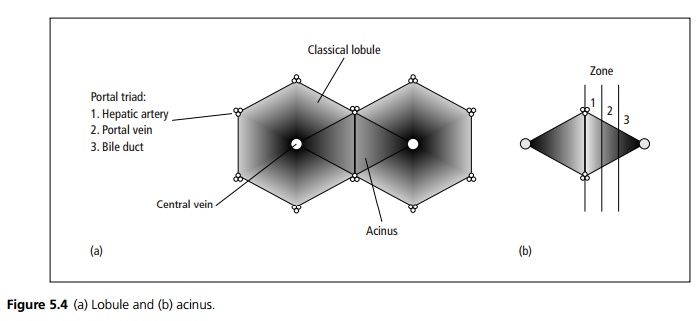Chapter: Medicine and surgery: Hepatic, biliary and pancreatic systems
Introduction to the liver and liver disease - Disorders of the liver
Disorders of the liver
Introduction to the liver and liver disease
Introduction to the liver
The liver is divided into two lobes, left and right (which includes the
caudate). It has two blood supplies: 25% of its blood originates from the
hepatic artery (oxygenated) and 75% originates from the portal vein that drains
the gastrointestinal tract and spleen. This blood is therefore relatively low
in oxygen, but rich in glucose, lipids and amino acids.
The functions of the liver are carried out by the hepatocytes, which
have a special architectural arrangement. Blood enters the liver through the
portal tracts, which contain the triad of hepatic artery, portal vein and bile
duct. It then filters from the edges of the lobule to the central (efferent)
vein. The lobule is classically used to describe the histology of the liver
(see Fig. 5.4a) but the acinus forms the functional unit (see Fig. 5.4b).

The hepatocytes in zone 1 of the acinus receive well-oxygenated blood
from the portal triads, whereas the hepatocytes in zone 3 receive
poorly-oxygenated blood and are therefore more vulnerable to damage when the
blood supply is compromised.
The liver has multiple functions, which may be impaired or disrupted by
liver disease:
·
Carbohydrate metabolism: The
liver is one of the major organs in glucose homeostasis under the control of
pancreatic insulin. Excess glucose following a meal is converted to glycogen
and stored within the liver. In early starvation states this glycogen is
mobilised, and once this store is exhausted glucose is synthesised via the
gluconeogenesis pathway within the liver.
·
Protein: The liver is involved in
the synthesis of all circulating proteins apart from immunoglobulin. This
includes carrier proteins, albumin and coagulation factors. The liver is also
involved in the breakdown of amino acids producing ammonia, which is converted
to urea and excreted by the kidneys.
·
Fat: The liver is involved in
synthesis of lipoproteins (lipid protein complexes), triglycerides and
cholesterol.
·
Bile synthesis and metabolism.
·
Drug and hormone inactivation and
excretion.
Liver disease can be considered according to the aetiology, the
pathology (such as acute hepatitis) or the clinical picture of presentation.
Related Topics